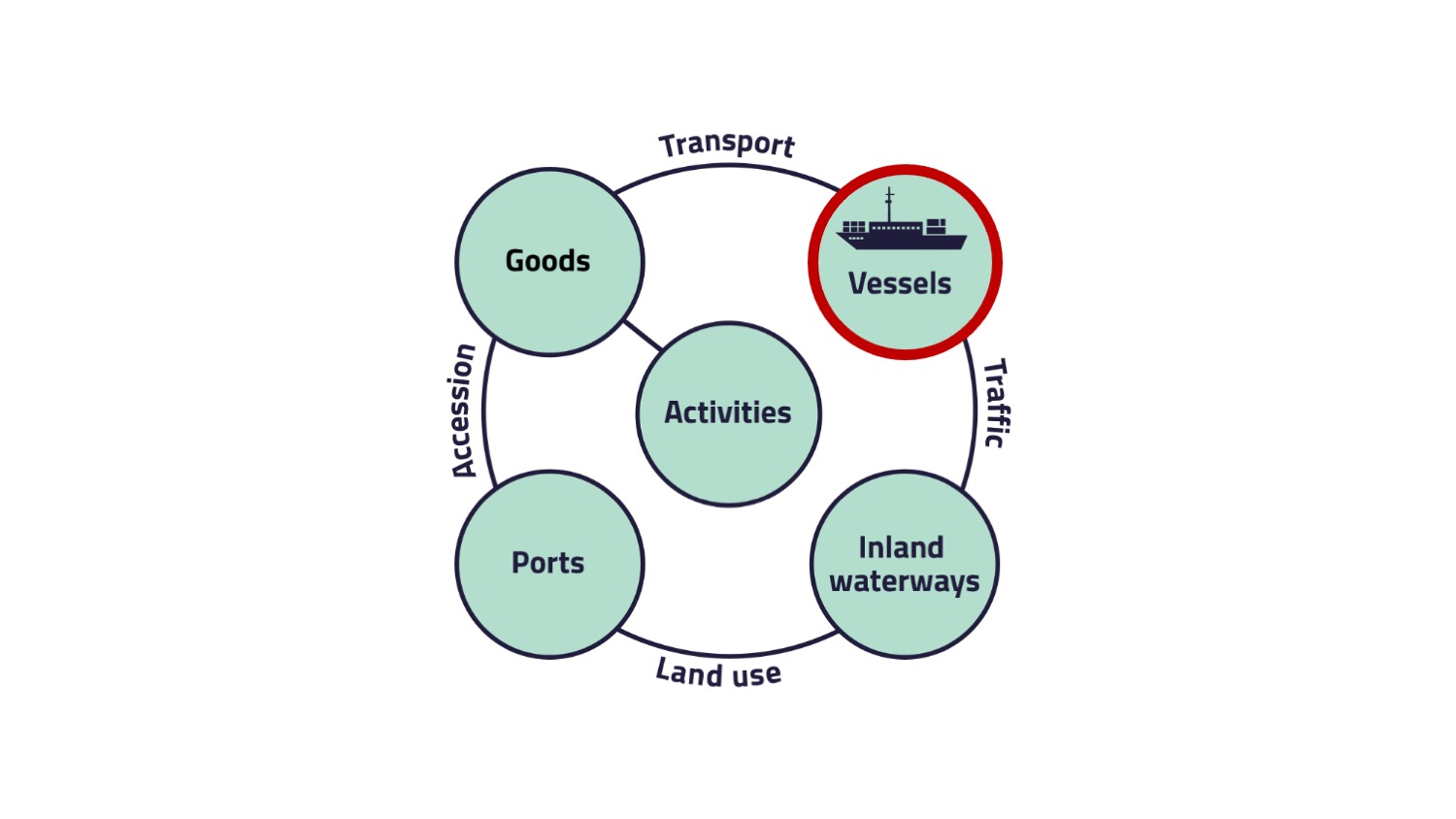Inland Waterway Transport System
4. Vessels
On this page, the element "Vessels" is described in detail. Different types of vessels are used for inland waterway transport, depending on the type of goods and the quantity to be transported.

The figure "Types of barges" shows different types of barges used for the inland waterway transport.

The first one is a container barge, which has no goods on board, but pushes barges with containers in front of it. The picture on the upper right shows again a push barge, but this time transporting bulk cargo. The picture on the lower left also shows a push barge. The last picture shows a Ro-Ro barge. Ro-Ro stands for Roll on-Roll off, which means that it transports moving goods, such as cars.
In comparison to the use of trucks for transport, an inland vessel has a much higher loading capacity. For example, a rather small ship with a loading capacity of 350 tons is about the same as the loading capacity of 14 trucks.
The longest type of inland vessels, the push barge, can have a loading capacity that is equivalent to 440 trucks.
Depending on the natural conditions and the used ship type, an inland container vessel with a capacity of 470 TEU can replace up to 470 trucks and a Ro-Ro Vessel up to 72 trucks, while a tank ship can replace up to 120 trucks.
We will now deal with the relation between vessels and inland waterway, called traffic.
In comparison to the use of trucks for transport, an inland vessel has a much higher loading capacity. For example, a rather small ship with a loading capacity of 350 tons is about the same as the loading capacity of 14 trucks.
The longest type of inland vessels, the push barge, can have a loading capacity that is equivalent to 440 trucks.
Depending on the natural conditions and the used ship type, an inland container vessel with a capacity of 470 TEU can replace up to 470 trucks and a Ro-Ro Vessel up to 72 trucks, while a tank ship can replace up to 120 trucks.
We will now deal with the relation between vessels and inland waterway, called traffic.
Traffic
In the past, only rivers and bodies of water were available for the transport of bulk goods.
With increasing industrialisation and the invention of the railway, regions without access to water were also connected to efficient transport networks.
Over time, the share of inland waterway declined. In Europe, most inland waterway transport is carried out in the Netherlands. In many countries, one waterway dominates, e.g.:
- In China, about 80 percent of inland waterway transport takes place on the Yangtse.
- In Germany, about 80 percent of inland waterway transport takes place on the Rhine.
As said above, the decision for the ship type of the inland vessel often depends on the natural conditions of the infrastructure of the inland waterways, which will be presented to you on the next page.
Literature
Literature
Flämig, H., Sjöstedt, L., Hertel, C. (2002): Multimodal Transport: An Integrated Element for Last-Mile-Solutions? Proceedings, part 1; International Congress on Freight Transport Automation and Multimodality: Organisational and Technological Innovations. Delft, 23 & 24 May 2002. (modification of Sjöstedt 1996)
Österreichische Wasserstraßen-Gesellschaft mbH (2007): Manual on Danube Navigation. URL: http://www.prodanube.eu/images/stories/downloads/Manual_Danube_Navigation_2007.pdf (last access: 30.03.2022).
Wasserstraßen und Schifffahrtsverwaltung des Bundes (2021b): Wasserstraße Rhein 2019/20 - Bilanz und Perspektiven. URL: https://www.gdws.wsv.bund.de/SharedDocs/Pressemitteilungen/DE/20210421_Wasserstrasse_Rhein_2019_2020_PM.html (last access: 30.03.2022).
Österreichische Wasserstraßen-Gesellschaft mbH (2007): Manual on Danube Navigation. URL: http://www.prodanube.eu/images/stories/downloads/Manual_Danube_Navigation_2007.pdf (last access: 30.03.2022).
Wasserstraßen und Schifffahrtsverwaltung des Bundes (2021b): Wasserstraße Rhein 2019/20 - Bilanz und Perspektiven. URL: https://www.gdws.wsv.bund.de/SharedDocs/Pressemitteilungen/DE/20210421_Wasserstrasse_Rhein_2019_2020_PM.html (last access: 30.03.2022).